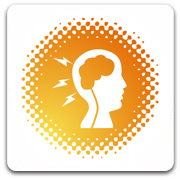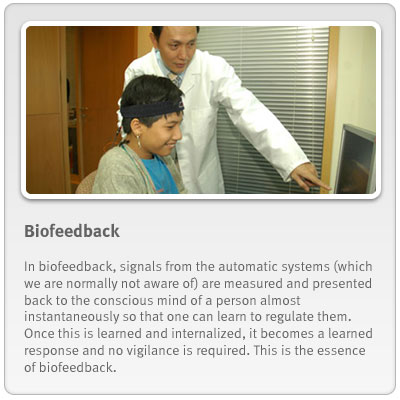Neurofeedback
 Neurofeedback is a form of biofeedback. Biofeedback therapy is recognized as a main-stream therapy and is used in hospitals in Singapore and around the world. Occupational therapists in St. Luke's Hospital use muscle tension biofeedback to train elderly stroke patients to relax their muscles. The Singapore General Hospital colorectal department has done many studies in Pelvic floor muscle biofeedback. Many hospitals in the USA use Galvanic Skin Resistance (GSR) and/or finger temperature biofeedback to train patients to cope with stress and anxiety.
Neurofeedback is a form of biofeedback. Biofeedback therapy is recognized as a main-stream therapy and is used in hospitals in Singapore and around the world. Occupational therapists in St. Luke's Hospital use muscle tension biofeedback to train elderly stroke patients to relax their muscles. The Singapore General Hospital colorectal department has done many studies in Pelvic floor muscle biofeedback. Many hospitals in the USA use Galvanic Skin Resistance (GSR) and/or finger temperature biofeedback to train patients to cope with stress and anxiety.
How Our Body produces signals
Our body produces a multitude of signals that can be measured using electronic instruments. Most of these signals are produced by the automatic nervous system in our body. We normally do not pay attention to these automatic systems, which include breathing, temperature control, heart beat, balance and etc.
 Our Brain produces signals too
Our Brain produces signals too
Our brain is certainly an automatic nervous system (the central nervous system). It sends out electrical signals called brain waves or electroencephalograph (EEG). These EEG signals indicate our brain states or arousal levels.
How Neurofeedback can help in brain functioning
The brain has the potential to be trained so that its brainwaves ‘behave' in a desirable and helpful way for the individual to function or learn in daily life. Neurofeedback trains the brain through providing feedback on one's brainwave through the form of computer games or other modalities.
Lasting change
Once successful in achieving a change in brainwave pattern over a period of training, the individual can experience a change in brain functioning such as having enhanced mental agility. The effect is enduring once the person starts to internalize the learning process. Subsequently, he/she will be able to produce the desirable brainwave patterns independently without needing any cues from the Neurofeedback system.
The Many Benefits of Neurofeedback
Using this technique, it is now possible to train a person's brain at various locations of one's brain. Neurofeedback has been proven to be a safe and effective alternative for the treatment of diagnosed conditions such as attention deficit hyperactive disorder, autism, learning disabilities, epilepsy, migraine, stress and more (See Applications ). Neurofeedback training also leads to improvements in various mental abilities such as improved attention and IQ (see Peak Performance ).

